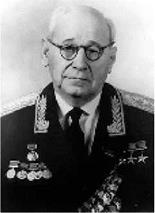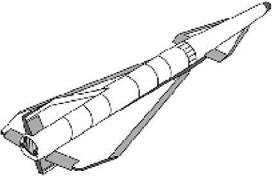Tupolev’s Zvezda
Spaceplanes were also studied in the early 1960s at the OKB-156 bureau of the Soviet Union’s most famous aircraft designer Andrey N. Tupolev. These studies had their roots in research conducted in 1957-1960 on an unmanned Long-Distance Glider (DP) intended to deliver thermonuclear warheads to enemy territory. According to original plans the DP was to be launched to an altitude between 50-100 km by a missile, either the R-5 or R-12, or a booster built at the Tupolev bureau itself. After separation from the rocket, it would gradually glide to its target, located up to
4,0 km from the launch pad. An on-board altimeter would then detonate the thermonuclear bomb at the required altitude.
Scale models of the DP were launched to speeds of up to Mach 2 with small solid rocket motors from Tu-16LL aircraft. OKB-156 also developed an experimental prototype of the DP called 130 or Tu-130. Weighing 2.5 tons, the tailless glider was 8.8 m long and 2.2 m high with a wingspan of 2.8 m. However, on 5 February 1960, just as the first Tu-130 was being readied for launch on a modified R-12 missile, the Soviet government issued a decree to cancel the DP project, now considered useless in the wake of the early ICBM successes. By this time OKB-156 had been aiming to launch the DP with a three-stage rocket built in-house, enabling the glider to cover distances of 9,000 to 12,000 km and carry a thermonuclear warhead weighing 3 to 5 tons.
The experience gained during the research on the DP came in handy for Tupolev’s spaceplane project, presumably started around 1960 under the names Aircraft 136, Tu-136, or Zvezda (“Star”) (Tu-136 is also the name of a recently developed regional cargo/passenger plane). The ultimate goal was to build a 10- to
|
Andrey Tupolev. |
|
The Zvezda spaceplane (reproduced from V. Rigmant, 2001). |
20-ton spaceplane to be orbited by a newly developed launch vehicle. Several aerodynamic shapes were studied, one closely resembling that of the 130 glider and another that of Dyna-Soar. In the end the designers opted for a canard configuration. If the experimental version was successful, it would serve as the basis for a whole series of rocket planes to be used for reconnaissance, bombing, and anti-satellite missions. Tupolev envisaged a grueling two-phase test program to verify the design at hypersonic speeds in the lower and upper atmosphere and to try out re-entry and landing techniques.
The first phase would see scale models of Zvezda being launched from Tu-16 aircraft and with the help of R-5 and R-14 missiles. The air-launched version would have a built-in solid rocket motor to reach an altitude of up to 40 km and a speed of
9.0 km/h. Models launched by the R-5 and R-14 would climb to 45 km and 90 km, respectively, and develop speeds of 14,000 km/h and 23,000-28,000 km/h.
The second phase involved the use of three manned test vehicles. One was a scaled-down version of Zvezda known as 136-1, air-launched from a Tu-95K. Having reached a peak altitude of 10 km and a top speed of 1,000 km/h, it would land at a speed of about 300 km/h, just like the real Zvezda. The next step was to use the Tu-95K as a launch platform for a hypersonic vehicle designated “139”. The Soviet equivalent of the X-15, it was to fly as high as 200 km and develop a speed of
8.0 km/h. The third vehicle was dubbed 136-2, an improved version of the 136-1 with an additional rocket engine to reach speeds of up to 12,000 km/h and a maximum altitude of about 100 km.
After this the stage would be set for the first launches of the actual Zvezda vehicle, which would fly between altitudes of 50 and 100 km and therefore be limited to single-orbit missions. There were also plans for an unmanned version called 137, Tu-137, or Sputnik, capable of performing multi-orbit missions. The only launch vehicle capable of launching Zvezda was Chelomey’s UR-500/Proton, but this was only in the very early stages of development when Zvezda was conceived. Therefore OKB-156 worked out plans for its own two – or three-stage rocket to launch the spaceplane. Also considered was a scheme in which the spaceplane would be launched with a missile from the back of a strategic supersonic plane (the Tu-135 or Tu-139).
Work on Zvezda was discontinued in 1963 for reasons that have not been disclosed [21].












